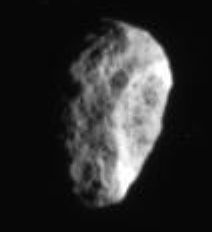Rev13 Hyperion Images

New images of Hyperion, taken over the last couple of days, are now posted on the JPL Raw images page. These images were taken from four times the distance of the images taken in June, but are not saturated like those images, allowing for better color information to be derived. Of course, this is but a taste of what is to come, as next month, on September 25, Cassini will fly within 500 km of the surface of Hyperion, allowing for the highest resolution coverage of Hyperion for the Cassini nominal mission. Images taken in June revealed a segregation of bright and dark material, with dark material occupying crater floors. They also revealed a fascinating array of crater morphologies, which maybe related to the effects of Titan on Hyperion's ability to re-accrete material from impacts on its surface. A rather "normal" looking simple crater can be seen in the image above, however, near the lower left.
Many of the images taken during orbit 13 have looked at areas made famous by Voyager. This region is dominated by a tall scarp known as Bond-Lassell Dorsum, which maybe the remnants of a large impact on Hyperion.
UPDATE: 08/18/2005 2:15 pm: Emily Lakdawalla has additional information on these images as well as an animated gif showing the sequence of images taken during this distant encounter on her Planetary Society Blog.


1 Comments:
According to CICLOPS, with a density of 0.6, Hyperion should have an internal structure that is 40% voids. Unless this void volume is perfectly distributed, impacts should rarely cause uniform craters. The more typical the crater 'roundness distribution', the less likely Hyperion is a low-density ‘rubble pile’.
The current crop of photos seems to indicate the craters are indeed atypical. The close pass September 25 should help determine if this impression holds true at higher resolutions: Get your spherical image analysis tools ready!
Post a Comment
<< Home